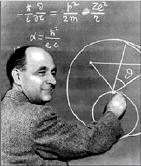The Life of Enrico Fermi

Click for a story about the photograph
On December 2, 1942, Enrico Fermi and his team of scientists harnessed the atom and opened the door to new scientific and technological realms. His achievement allowed the U.S. to produce the atomic bomb that helped end World War II. Now, more than fifty years later, nuclear energy provides a significant part of the world's electrical power, and radioactive materials are used for hundreds of industrial, agricultural, and medical applications-from food preservation to cancer therapy, checking the integrity of welds in pipelines and bridge supports, and gauges that measure the thickness of coatings applied to paper.
Fermi was born in Rome in 1901 and received his doctorate from the University of Pisa in 1922. During 1923 to 1924, he studied in Göttingen, Germany, with Max Born, and in Leiden, The Netherlands, with Paul Ehrenfest. From 1924 to 1926, Fermi lectured in mathematical physics and mechanics at the University of Florence. He became the first professor of theoretical physics at the University of Rome, where he taught for 12 years.
In 1938, Fermi traveled to Stockholm to receive the Nobel Prize "for his identification of new radioactive elements produced by neutron bombardment and his discovery, made in connection with this work, of nuclear reactions effected by slow neutrons." Fermi's wife Laura, in her book Atoms in the Family*, wrote, "Four years of patient researches; the broken and the unbroken tubes full of beryllium powder and radon; the strenuous races along the hall of the physics building to rush element after element to the Geiger counters; the efforts to understand nuclear processes, and the many tests to prove the theories ... these had won the Nobel Prize for Enrico."*
By 1938, Fascist Italy had become intolerable to Fermi. He used his trip to Stockholm as an opportunity to flee. He and his family sailed directly to the United States, where he had visited many times before. In the months before his Stockholm trip, he had sought teaching positions in America and had received offers from five universities. He chose a professorship in Physics at Columbia University. There, in 1939, he confirmed the discovery of the fission process and began striving to attain a nuclear chain reaction.
From 1942 to 1944, Fermi worked at the Metallurgical Laboratory of the University of Chicago. In a makeshift laboratory under Stagg Field Stadium, he designed and built the first nuclear reactor and led the epochal experiment that demonstrated the first self-sustained chain reaction. More than any individual, he was responsible for developing a means for the controlled release of nuclear energy.
Fermi became a U.S. citizen in 1944. From 1944 to 1945, he became Associate Director of the Los Alamos National Laboratory in New Mexico. In 1946, he returned to the University of Chicago as a professor at the Institute of Nuclear Studies, which now bears his name--Fermi Institute. He resumed his fundamental research interests in nuclear and elementary particle physics and also, beginning in 1950, served as one of the first members of the General Advisory Committee of the Atomic Energy Commission.
On November 16, 1954, President Eisenhower and the Atomic Energy Commission gave Fermi a special award for his lifetime of accomplishments in physics and, in particular, for the development of atomic energy. Fermi's other research resulted in the Fermi-Dirac particle statistics, the theory of beta-decay, the Thomas-Fermi model of the atom, and a theory of the origin of cosmic rays.
Fermi died on November 28, 1954, and the Enrico Fermi Award was established in 1956 to perpetuate the memory of his brilliance as a scientist and to recognize others of his kind-inspiring others by his example.
*Laura Fermi, Atoms in the Family, University of Chicago Press, Chicago, 1954, pg. 123.


